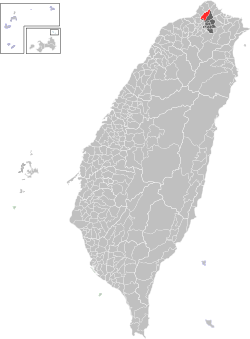Peitou
|
Beitou 北投區 |
|
|---|---|
| District | |
| Beitou District | |

Hot Spring Valley in Beitou
|
|
 |
|
| Country | Republic of China (Taiwan) |
| Region | Northern Taipei |
| Divisions |
List
|
| Area | |
| • Total | 56.8216 km2 (21.9389 sq mi) |
| Area rank | Ranked 2nd of 12 |
| Population | |
| • Total | 257,922 |
| • Rank | Ranked 5th of 12 |
| • Density | 4,500/km2 (12,000/sq mi) |
| Postal code | 112 |
| Website | www.btdo.taipei.gov.tw (in Chinese) |
| Beitou | |||||||||||||
| Traditional Chinese | 北投區 | ||||||||||||
|---|---|---|---|---|---|---|---|---|---|---|---|---|---|
|
|||||||||||||
| Transcriptions | |
|---|---|
| Standard Mandarin | |
| Hanyu Pinyin | Běitóu Qū |
| Wade–Giles | Pei3-t'ou2 Ch'ü1 |
| Southern Min | |
| Hokkien POJ | Pak-tâu-khu |
Beitou District is the northernmost of the twelve districts of Taipei City, Taiwan. The historical spelling of the district is Peitou. The name originates from the Ketagalan word Kipatauw, meaning witch. Beitou is the most mountainous and highest of Taipei's districts, encompassing a meadow with rivers running through the valley which have abundant steam rising from them; the result of geothermal warming. The valley is often surrounded by mist shrouding the trees and grass. Beitou is famous for its hot springs. In March 2012, it was named one of the Top 10 Small Tourist Towns by the Tourism Bureau of Taiwan.
In the early Japanese era, Hokuto (Pak-tau) was a village at the entrance of the well-known North Formosa sulfur district. Three Japanese extracting plants in this district produced about 200 short tons (180,000 kg) of sulfur monthly. The Japanese had already recognized the value of the village as a sanitary resort and constructed a Japanese inn with hot mineral baths provided by the sulfur springs. The hot springs have been developed to include aroma therapy, massage, acupuncture, hydrotherapy, and excellent cuisine which complement the entire spa experience. The mineral waters stream from the numerous geothermal vents that occur naturally in the region and are famous for their health benefits.
Between 1920 and 1941, Hokutō Village (北投庄) was governed under Shichisei District, Taihoku Prefecture. It was upgraded to a Hokutō Town in 1941.
After the handover of Taiwan from Japan to the Republic of China in 1945, it was renamed as Peitou urban township (北投鎮), belonging to Taipei County. Beginning in 1949, Peitou and Shilin were administered by the newly formed Yangmingshan Administrative Bureau. Both of them were merged into Taipei City on 1 July 1968 as districts. In 1974, Yangmingshan Administrative Bureau underwent restructuring and Beitou District was placed under direct jurisdiction of Taipei City.
...
Wikipedia
